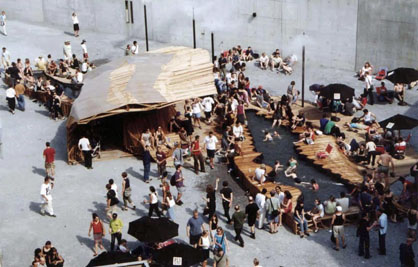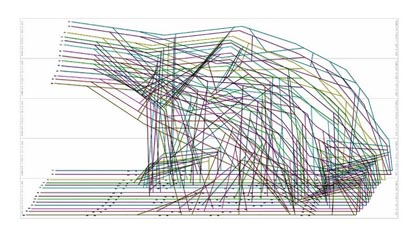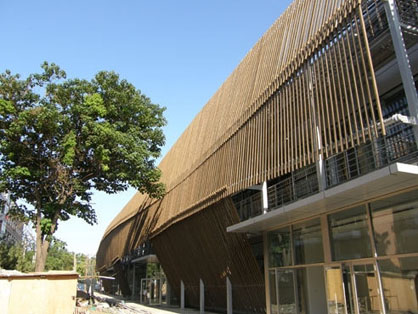|
|
| home > coffee break > it revolution |
| Lab in action Antonino Saggio |
||||
 Stefano Converso SHoPWORKS. Collaborazioni costruttive in digitale (IT Revolution in Architecture) Edilstampa 2008 pp. 96, € 14,00 preface by Antonino Saggio buy the book online |
||||
| [in
italiano] |
Louis Sauer, American architect with a deep expertise in housing, often used to underline a key point: how important it is to work within the development process, that is to say within the network of reciprocal conditionings put in place by the various actors of the building process. As a matter of fact, only the operative capacity, the methodology and the operative flexibility which are peculiar to the architect can guarantee that the building process -which is intrinsically adversarial- has the opportunity to enhance the project instead of determining a progressive qualitative decay. When I came to know Sauer, his statements and his articles were definitely a minority position. On one side there were the stars of architecture who were not interested in an approach that may appear as a compromise, because they had the strength to impose their "famous self" and, therefore, their decisions; on the other side the great bulk of the professionals who were almost resigned to see the project eroded by the prevailing of sectorial forces and to accept as inescapable the fact that every step towards the completion was bound to become a step towards the depletion of the project itself, rapidly leading to the generalized lack of quality that is peculiar to the greatest part of the building output around the world. Louis was instead stressing the importance of developing a consciousness of these conflicts and was underlining the need to develop methods that could 'guide' those conflicts towards the maintenance (or, better, the enhancement) of quality. He wanted to overcome the resignation, replacing it with a consciousness created by the possession of new 'tools': "How you can work with developers and actually enjoy it", was a slogan of his and the interest he had raised with his numerous projects (particularly those in Society Hill, Philadelphia) was a concrete example. |
[august 15, 2009] | ||
 SHoP diagrams showing different kinds of relationship among the different actors in the development process. The only one that is rejected by them is the one that doesn't imply any intersection between the activity of the office and the one of the other subjects involved. There were some cultural and scientific supports to this approach. To name a few: John Habraken's work and the activity of the Sar from the Netherlands, Christopher Alexander's philosophical and (at the same time) methodological research, John Zeisel's sociological analysis, Oscar Newman's environmental psychology and also those parts of the research that were associating the problem solving approach to the emerging techniques of artificial intelligence -an example was Herbert Simon's work. I had dedicated quite a bit of attention to this sphere of research in the mid-80s, during my long period in the US – both with a monograph on Louis Sauer and with a pamphlet ("Using goals in design") in which methods and procedures for a qualitative work within the development process were outlined. It was 1988.  Extension of the Fashion Institute of Technology, New York. Diagram made with GenerativeComponents, of the "digital structure" for the facade, shared with engineers and consultants (Buro Happold and Front). Twenty years from those studies, this book by Stefano Converso brings back the spotlight on the issue of the collaboration within the design process. This is done through two important aspects. The first one is represented by the 'maturity' reached by the ensemble of computing tools. Computing is intrinsically flexible, can be easily scaled on parameters and shaped on models and these are features that are decisive in the management of a collaborative approach. As a matter of fact computing allows the creation of models based on constantly adjustable parameters and gives the opportunity to deal with complex negotiations between aims that can be -at least apparently- divergent. Aims that, if not adequately managed with the appropriate tools and methods, can determine an impoverishment of the project, while -if correctly dealt with through the right tools (computing)- can not only be successfully achieved, but can even lead to new and unexpected creative solutions (and Sauer's work had fully demonstrated this). The second important aspect of Converso's book is the inclusion of a relevant case study as an example of this approach: SHoP Architects' activity. SHoP is a NY-based emerging studio who has positioned its activity at the crossroad of important and topical aspects.   Top view of the DUNESCAPE installation at P.S.1 Musem, New York and image of the only construction document prepared: a 1:1 template for the wooden components cut on site. First of all, one of SHoP's main feature is its "anti-star" attitude. Listening to the other actors and -through the use of new computing tools- collaborating with them is a must in their approach. On top of that there is a strong sense of experimenting and 'pioneering' solutions -in each and every project they work on, both in the 'demos' they developed in early 2000 and in the more sophisticated works they have delivered more recently. A third important element in their activity is a constant figurative research -that is focused on the theme of variations, mobile textures and components that are modified to pursue a contemporary and digital dimension. |
||||
 North elevation of the SanLiTun mall in Beijing. Converso's book analyzes SHoP Architects with an attention which is analytical of the specific evolution and research in every project but at the same time maintains a general overview. This makes it possible to retrace the steps that brought young architects to experiment (often with poverty of means) a digital dynamics in planning and execution. The second relevant aspect of this book is the attention that the author gives to the various software used by SHoP. Tools that allow to execute projects, create models and facilitate the interaction with the developer and the builders. The fact that the results achieved by SHoP are important gives even more credit to the process the American office has been developing and that is outlined by Converso in a remarkable and precise way. Last but not least, the author introduces us to a series of neologisms -such as kit, versioning, tailoring, etc- that are by themselves the representation of a profoundly new way to deal with the aspects of plannig. SHoP works. Antonino Saggio |